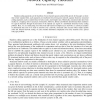24 search results - page 1 / 5 » The Case for Structured Random Codes in Network Capacity The... |
CORR
2008
Springer
13 years 5 months ago
2008
Springer
Random coding arguments are the backbone of most channel capacity achievability proofs. In this paper, we show that in their standard form, such arguments are insufficient for pro...
INFOCOM
2002
IEEE
13 years 9 months ago
2002
IEEE
Abstract— In [1], Gupta and Kumar determined the capacity of wireless networks under certain assumptions, among them point-to-point coding, which excludes for example multi-acces...
CORR
2010
Springer
13 years 5 months ago
2010
Springer
The min-cut value towards a single receiver in a network with unit capacity edges can be achieved by routing a single bit. The multicast theorem in network coding shows that, the c...
SODA
2008
ACM
13 years 6 months ago
2008
ACM
We prove that binary linear concatenated codes with an outer algebraic code (specifically, a folded Reed-Solomon code) and independently and randomly chosen linear inner codes ach...
STOC
1994
ACM
13 years 9 months ago
1994
ACM
Shannon's Coding Theorem shows that in order to reliably transmit a message of T bits over a noisy communication channel, only a constant slowdown factor is necessary in the ...

